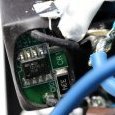Leaderboard
Popular Content
Showing content with the highest reputation on 04/14/21 in all areas
-
Ich wollte hier mal meinen aktuellen Stand zeigen. Meinen Server habe ich selbst in einem 10 Zoll Rack verbaut: HDDs und Motherboard sind auf simplen Rackböden montiert: Hardware MB: Gigabyte C246N-WU2 CPU: Xeon E-2146G mit Boxed Kühler vom i3-9100 (der vorher verbaut war) RAM: 64GB ECC NT: Corsair SF450 Platinum LAN: 10G QNAP Karte HDD: 126TB bestehend aus 1x 18TB Ultrastar (Parität) und 7x 18TB WD Elements (Ultrastar White Label) Cache: 1TB WD 750N NVMe M.2 SSD USV: AEG Protect NAS quer auf Gummifüßen Als Server-Namen habe ich "Thoth" gewählt, da dies der ägyptische Gott der Weisheit war. Das verleitet auch manchmal dazu ihn "Thot" zu nennen. ^^ Bei 8 stehenden HDDs liegt der Verbrauch im Leerlauf bei 23W: Disk-Übersicht: Beim Hochladen direkt auf die Disks komme ich auf über 90 MB/s, was ich den schnellen HDDs zu verdanken habe: Auf den Cache sind natürlich 1 GB/s kein Problem: Dank 50% RAM-Cache gehen aber auch die ersten 30GB auf die HDDs mit 1 GB/s: Diese Kombination aus Performance und geringem Stromverbrauch bietet nur Unraid 😍 Ich betreibe außerdem noch einen Unraid Backupserver an einem externen Standort. Dieser nutzt ein Asrock J5005 und ist möglichst kompakt / günstig aufgebaut, wobei ich in einem Bitfenix ITX Case einen zusätzlichen HDD Käfig eingepasst habe, um 9 HDDs verbauen zu können:3 points
-
Today's blog follows a couple of student's educational journey with Unraid in their classroom: https://unraid.net/blog/unraid-in-the-classroom If you are an educator and would like to teach with Unraid in the classroom, please reach out to me directly as we would love to support this educational program at your place of instruction!3 points
-
I've made the correction and moved the ruleset definition before the include. Note To make this work, the user has to delete the files /config/rsyslog.conf and /config/rsyslog.cfg from the USB device. Reboot the server and reconfigure the syslog service in the GUI again.2 points
-
I am using flash drives that I have had for 5 years plus with no problems. My experience is that if you stick with USB2 drives and avoid the tiny form factor ones they DO tend to be reliable.2 points
-
Hopefully @giganode has not too much to do so he can answer here soon since he is the guy who can help with the AMD cards.2 points
-
I was taking my monthly look at my server to see where my SSD's were at in regards to TB Written (Data units written) as most SSD's have a limited warranty of something like 5 years of 320 TB Written in the case of my SX8200 Pro. There is currently a Warranty Period field where you can enter a warranty that is limited to 5 years: - Unknown - 6 Months - 12 Months - 24 Months - 36 Months - 48 Months - 60 Months It would be nice to expand that list since some drives have 6+ years or allow a custom entry with just a number field and a dropdown for months or years. It would also be nice to have a secondary warranty condition that can be linked to the Data units written so I can enter in a value in TBW for an SSD. Finally, it would be great to have this added to the Alerter/Notifier and its settings to be able to be able to trigger alerts and emails when a drive is nearing it's warranty, say 10% away from either of the defined warranty periods, and then another time when it has surpassed either defined warranty period.1 point
-
This release contains bug fixes and minor improvements. To upgrade: First create a backup of your USB flash boot device: Main/Flash/Flash Backup If you are running any 6.4 or later release, click 'Check for Updates' on the Tools/Update OS page. If you are running a pre-6.4 release, click 'Check for Updates' on the Plugins page. If the above doesn't work, navigate to Plugins/Install Plugin, select/copy/paste this plugin URL and click Install: https://s3.amazonaws.com/dnld.lime-technology.com/stable/unRAIDServer.plg Bugs: If you discover a bug or other issue in this release, please open a Stable Releases Bug Report. Thank you to all Moderators, Community Developers and Community Members for reporting bugs, providing information and posting workarounds. Please remember to make a flash backup! Edit: FYI - we included some code to further limit brute-force login attempts; however, fundamental changes to certain default settings will be made starting with 6.10 release. Unraid OS has come a long way since originally conceived as a simple home NAS on a trusted LAN. It used to be that all protocols/shares/etc were by default "open" or "enabled" or "public" and if someone was interested in locking things down they would go do so on case-by-case basis. In addition, it wasn't so hard to tell users what to do because there wasn't that many things that had to be done. Let's call this approach convenience over security. Now, we are a more sophisticated NAS, application and VM platform. I think it's obvious we need to take the opposite approach: security over convenience. What we have to do is lock everything down by default, and then instruct users how to unlock things. For example: Force user to define a root password upon first webGUI access. Make all shares not exported by default. Disable SMBv1, ssh, telnet, ftp, nfs by default (some are already disabled by default). Provide UI for ssh that lets them upload a public key and checkbox to enable keyboard password authentication. etc. We have already begun the 6.10 cycle and should have a -beta1 available soon early next week (hopefully).1 point
-
I have one that has run 24x7 for years as have many others. It get restarted for upgrades of OS and hardware and when changing disk configuration, but other than that, it runs 24x7. With my electricity costs, running for a month at idle would cost about $2. I figure that is my real cost of running it 24x7 as other uses of the server cost what they cost to use it as intended. Like Kizer, all my disks spin down after a period of inactivity (1 hour in my case) and all dockers and VMs are on SSDs.1 point
-
So we finally got a couple people back on the server playing at the same time. There was minimal building but mainly a long lasting boss fight. And weirdly enough the server recorded inverse RAM spikes during the time this was happening (from 20:00 to 2:00 with a small break at 23:00 ish)... Other than that the RAM usage had continued the same pattern between 3.5 GB and 4 GB. At this point it really just seems like a Valheim server software 'feature' so I probably won't continue with updates here as there's nothing Ich77 can do about that! Thanks1 point
-
I have flash drives in use since the unRAID 4.7 days... more than 10 years ago. 1 is a USB 1.0 drive and the other is a USB 2.0 drive. both are running fine and not given me any problems. If you are losing USB drive at 1 per year that seems quite excessive for the amount of writes that should be going to a flash drive normally.1 point
-
removed my config.plist.. https://drive.google.com/file/d/1ARQY5izoaMkcGQ8L3px5s5Orzf0haMPT/view?usp=sharing1 point
-
Hey! Let me share my syslinux config which works on my system... label Unraid OS menu default kernel /bzimage append video=vesafb:off,efifb:off vfio_iommu_type1.allow_unsafe_interrupts=1 isolcpus=4-15,20-31 pcie_acs_override=downstream,multifunction initrd=/bzroot ( Do not just copy & paste this) I guess you do not allow unsafe interrupts? What is the behaviour if you try a linux vm?1 point
-
The screenshots indicate that both video decoding and video encoding are hardware accelerated. However, the GPU can only transcode the video stream. What it can't do is re-wrap from MKV to MP4, transcode the audio or burn in subtitles - they all use the CPU and the CPU also has to feed the GPU with data. I don't know what you were expecting to see but it looks about right to me. Try turning off the subtitles and see how much of a difference it makes.1 point
-
1) make sure your current config is NOT set to auto start the array. 2) note the position of each drive, as listed in unRAID. cross-reference with the serial# on each disk if needed. TAKE SPECIAL NOTE OF PARITY! 3) move the disks and flash drive to the new machine and boot. 4) your array will most likely be all wrong. do a new config, assign the disks as they were before, and ESPECIALLY THE PARITY! 5) if you did it right, you can tag the parity as VALID, and go on with your life. otherwise, you can rebuild parity, but only AFTER you verify all your data drives are present and populated.1 point
-
Hi, also seem to be having issue at the moment. Logs showing some errors. can you offer any advice please. Unable to access the GUI. PC on same network as unraid/deluge 192.168.10.0/24 Getting this 2021-04-14 14:45:41,730 DEBG 'start-script' stdout output: [warn] Unable to successfully download PIA json to generate token from URL 'https://10.0.0.1/authv3/generateToken' [info] 4 retries left [info] Retrying in 10 secs... Thanks supervisord.log1 point
-
1 point
-
1 point
-
1 point
-
that will be why you cannot access it now, as 'LAN_NETWORK defined as '10.10.20.0/24'' and your IP will now be in a different range and thus blocked. this might of been fixed by switching endpoint, it def looks to be working now, so i think your issue is now that you are blocked on your vpn range due to LAN_NETWORK not including your vpn range, see previous comment above, wait till you get home and try it on your lan, or alternatively add in your vpn range to LAN_NETWORK (use comma to separate the networks) and restart the container and try accessing the web ui again. no not true, debug just gives more verbose output, it does not stop the web ui from running.1 point
-
1 point
-
Problem are eth117 / br117, suspect cause by dirty setting in network config file. A simple way was delete whole config file or edit yourself.1 point
-
1 point
-
I managed to get my FiveM server up and running using the info in this thread to get the txadmin set up. I was having issues getting the recipe to run for the base ESX default recipe. I had to add the mariadb docker containers and myphpadmin docker containers. it appears to be saving and working curerntly but it's 6AM and I'm calling it a night if anyone else has set up an ESX roleplaying server I'd like to know how you did it and what issues you encountered. I currently can't figure out how to update txAdmin it says I'm using an outdated version but it works so I guess the annoying red text will just be there for now lol.1 point
-
No idea..but start reading from here: It seems @giganode solved the same issue by changing the refresh rate.1 point
-
You are a god damn hero. Thank you! I seem to be full up round again.1 point
-
@stinger2k I also agree with @SimonF that a plugin should never change another plugin and it's up to the user so that he makes sure that the device is available. If it would be done like this the main problem is if a user selects by accident a device that has a partition or something mounted he can delete all of the contents of this device.1 point
-
1 point
-
As I recently added a (12tb) disk and was interested in this thread. My journey... Before getting UnRAID, I had a 24tb RAID5 (4x6tb = 18tb usable, 1 parity). I now I have an UnRAID with 3x12tb and 1x6tb. I "decided" to loose 12tb to parity and have 30tb usable. The "old" RAID5 I use for backup now. I had a drive fail in the RAID5 and it rebuilt fine, but it wasn't pleasant. It takes a LONG time to transfer/save/rebuild data. Backup is everything; parity is making it "easy." I say, "easy" because I spent weeks transferring data to UnRAID. Test how long it takes to transfer 30tb of data and consider your server being down for that length of time. Parity is worth it when it works; and backup is everything if parity fails. Just my two cents worth. 6.1 point
-
As far as I know you're not at RAID anything. Why do you think you're at RAID 0? Your 2 data disks are independent and provide no redundancy. And I'm not suggesting RAID anything. Unraid IS NOT RAID. Even after you add parity you won't be at RAID anything, at least not technically. Unraid allows a parity disk that lets you rebuild a missing disk from parity and all the other disks, but the implementation is different from any traditional RAID. Unlike RAID, Unraid allows you to mix different sized disks in the array, and you can easily add disks without rebuilding the array. Also, each data disk in the array is an independent filesystem that can be read all by itself without the other disks. This also means no striping, of course, so Unraid won't be as fast as striped RAID.1 point
-
I am suggesting that parity is never a substitute for backups. But parity is still a good idea. Don't cache the initial data load. Never try to cache more than cache can hold. It is impossible to move from cache to array as fast as you can write to cache. If you keep all the source data until after you get it all copied to your Unraid server, you could wait until then to add parity since the copy would go faster without parity. Then, after making sure you have another copy of anything important and irreplaceable, you could reuse the disks with the source data in your new server. You get to decide what qualifies as important and irreplaceable.1 point
-
Article on Linux Steam link for those who come across this thread https://www.slashgear.com/steam-link-linux-release-reminds-us-how-simple-game-streaming-can-be-03662133/1 point
-
Turns out this is pretty simple to implement. It requires editing core files - which means it'll probably be lost one day on upgrades. I have no idea if this can be done with a community app, but this is at least a beginning for us who are used to docker-compose but still able to use the dynamix docker manager web interface. Tested this in version 6.9.2 I take no responsibility if you break something. Make sure you have a backup of this file before you begin. It would be great to see this included in the core of unraid since it's such a simple addition. Edit /usr/local/emhttp/plugins/dynamix.docker.manager/include/DockerClient.php Look for public function getAllInfo($reload=false) { and at the very end of the foreach add: if ($ct['Icon']) $tmp['icon'] = $ct['Icon']; if ($ct['url']) $tmp['url'] = $ct['url']; Look for public function getDockerContainers() { and inside the foreach, beneath the line containing $c['BaseImage'], add: $c['Icon'] = $info['Config']['Labels']['net.unraid.docker.icon'] ?? false; $c['url'] = $info['Config']['Labels']['net.unraid.docker.webui'] ?? false; Clear browser cache and reload the unraid web ui. Icons and webui links from unraid templates still work, and those from a docker container label also now work.1 point
-
I found the solution to this particular problem: I had to enable "Host access to custom networks" in the Advanced Docker settings and enable the desired Subnet.1 point
-
For now forget about increasing or evaluating security and GET THOSE THINGS BACKED UP. Once you have offline backup of items you can't afford to lose, then start dealing with the rest of this. Once you have a backup strategy in place, then you can start evaluating open ports and examining the security of each of the answering services. Of course all this assumes you haven't put your server in the DMZ or anything like that.1 point
-
...was ist das fürn MB? 2x SATA3 und 2x SATA2, nur eine M.2 unbekannter Spezifikation.....zumindest wenn man dem reichsten Mann der Welt trauen darf. Hast Du nen guten Feuermelder und ne Versicherung? Ganz ehrlich...ein gebrauchter namhafter Dell, Fujitsu, Lenovo oder HP, zur Not auch in DDR3 tut es auch, wenn nicht noch was besseres zu finden ist. Was ist Dein Budget, ohne Platten? Edit: bzw. was genau hast Du schon auf dem Tisch?1 point
-
Woah, Nelly! Just hit 65MB/s over Wireguard before even configuring an ideal endpoint. That dog'll hunt. Thank you boys.1 point
-
But, how do I do that in Unraid with Plex in docker? Is there an easy way? Edit: I'm using this docker (are there any differences on the dockers, anyone I should use instead?). https://hub.docker.com/r/linuxserver/plex/ and when when changing from "latest" to "1.22.0.4163" in VERSION on the "edit docker page" in Unraid and press Apply, I'm still on Version 1.22.2.4282 in app.plex.tv when I'm checking from a browser. Edit2: Is it version-1.22.0.4163-d8c4875dd I shall write instead? Or do I need to specify more? Edit3: 1.22.0.4163-d8c4875dd was the exact line. Now I'm down do the working version. When Plex has fixed the problem, what is the best version to be on then? docker, latest or public? /Söder1 point
-
change the endpoint, see q28 for how to do this:- https://github.com/binhex/documentation/blob/master/docker/faq/vpn.md1 point
-
DEVELOPER UPDATE: 😂 But for real guys, I'm going to be stepping away from the UUD for the foreseeable future. I have a lot going on in my personal life (divorce among other stuff) and I just need a break. This thing is getting too large to support by myself. And it is getting BIG. Maybe too big for one dash. I have plenty of ideas for 1.7, but not even sure if you guys will want/use them. Not to mention the updates that would be required to support InfluxDB 2.X. At this point, it is big enough to have most of what people need, but adaptable enough for people to create custom panels to add (mods). Maybe I'll revisit this in a few weeks/months and see where my head is at. It has been an enjoyable ride and I appreciate ALL of your support/contributions since September of 2020. That being said @LTM and I (mostly him LOL) were working on a FULL Documentation website. Hey man, please feel free to host/release/introduce that effort here on the official forum. I give you my full blessing to take on the "support documentation/Wiki" mantel, if you still want it. I appreciate your efforts in this area. If LTM is still down, you guys are going to be impressed! I wanted to say a huge THANK YOU to @GilbN for his original dash which 1.0-1.2 was based on and ALL of his help/guidance/assistance over the last few months. It has truly been a great and pleasurable experience working with you man! Finally, I want to say a huge thanks to the UNRAID community and its leadership @SpencerJ @limetech. You guys supported and shared my work with the masses, and I am forever grateful! I am an UNRAIDer 4 LIFE! THANKS EVERYONE!1 point
-
@giganode @saber1 bestreicht mich mit Butter und nennt mich Toast 😅 Ich habe es hinbekommen. Nvram habe ich iMacPro1,1 ausgewählt und dieser hat mir dann auch Werte in Smbios eingetragen. Ausschlaggebender Punkt war allerdings, dass ich mit dem Hackintool den PCI-Namen der Netzwerkkarte auslesen musste und diesen unter "DeviceProperties" eintragen muss. Dort den Key "built-in" mit dem Wert "01" und "DATA" eingeben, Hacki neustarten und jetzt hat die Anmeldung geklappt. Wenn Sie mich morgen nicht abholen, scheinen se auch nichts dagegen zu haben 😁😆1 point
-
Ich würde vorschlagen die Datenbank zu sichern bzw in eine neue Datenbank zu kopieren. Mit der spielt man dann. Also den anderen Nextcloud-Container installieren, stoppen und dann die Web-Dateien und Shares in das Verzeichnis des neuen Containers kopieren. Im letzten Schritt dann in der config.php des neuen Containers die Datenbank so anpassen, dass sie sich mit der Kopie verbindet und zum Schluss starten und schauen was passiert. Solange man nur mit den Kopien der Daten arbeitet, kann ja nichts schief gehen. PS Ich nutze zum Abgleich von Verzeichnissen und Dateien Beyond Compare. Dann sieht man ob die Installationen sich irgendwo gravierend unterscheiden, wobei sie das bei gleicher Version ja eigentlich nicht tun sollten.1 point
-
Don't know if this has been mentions yet but, quicksync stops working after version 1.22.0.4163. I tested this across multiple containers, each with the same results.1 point
-
Good Afternoon everyone, I currently use untangle as my home router, the only issue being it does not have avahi/mDNS feature built into it. This creates an issue with smart home devices as this is a critical service for them to function. Does anyone know of a way to use unraid, preferably a docker, to be the mDNS forwarder/server for the network, to keep the devices off the main network, but still allow stuff like that to work?1 point
-
Hi, I have the same requirement and I've been using a Raspberry Pi running Raspbian with avahi daemon connected to all my VLANs for this purpose. I only noticed today during some unRAID maintenance that the mDNS/avahi daemon seems to be part of the operating system. So I am *also* curious if I can get this working using uNRAID rather than having to maintain my Raspberry Pi.1 point
-
maybe add a feature => buton to mark the topic as solved automaticaly, would be nice1 point
-
To rebuild to same disk: Stop array Unassign that disk Start array with disk unassigned Stop array Reassign that disk Start array with disk reassigned to begin rebuild1 point
-
Note to self: info here: https://packaging.python.org/tutorials/installing-packages/#ensure-you-can-run-pip-from-the-command-line pip does not work from scratch, first run: python -m ensurepip --default-pip Then optionally upgrade pip using: pip install --upgrade pip And then just install the package from https://pypi.org/project/requests/ using: pip install requests1 point
-
If your problem is solved, or was a simple misconception on your part, then please do NOT delete the thread. Other users may still find it interesting, and there may also be links within other threads to your posts1 point

































